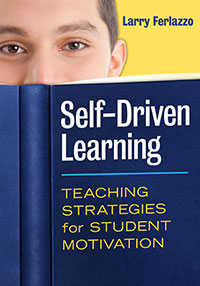Empowering Self-Driven Learners
Self-Driven Learning: Teaching Strategies for Student Motivation
by Larry Ferlazzo
(Eye on Education/Routledge, 2013 – Learn more)
Empowering. That word sums up Larry Ferlazzo’s latest book.
While the theme of the book is helping students develop intrinsic motivation and life skills that better equip them to deal with challenges in and outside of school, the book also empowers and helps educators with research based strategies that are clearly described and applied in detailed lesson plans.
Educators who read this book will become more effective teachers who are better equipped to deal with daily challenges of motivating our students.
What motivates the chicken?
 As I read this book, I thought about that classic question: Which came first, the chicken or the egg? As teachers, we feel the stress of “producing” high test scores — let’s call them the ‘golden eggs’ — from our students. We are handed the latest pre-packaged curriculum (too often lacking in quality or ongoing professional development). The contents of the box or binder are intended to guide each of our instructional days and lead our students to success (the golden eggs) so long as we follow the teacher guides with “fidelity.”
As I read this book, I thought about that classic question: Which came first, the chicken or the egg? As teachers, we feel the stress of “producing” high test scores — let’s call them the ‘golden eggs’ — from our students. We are handed the latest pre-packaged curriculum (too often lacking in quality or ongoing professional development). The contents of the box or binder are intended to guide each of our instructional days and lead our students to success (the golden eggs) so long as we follow the teacher guides with “fidelity.”
If this curriculum doesn’t work for some of our students, we identify them as poor egg producers in need of intensive intervention (i.e., another pre-packaged curriculum). But what about the chicken? What motivates the chicken to consume the food it needs to produce those golden eggs we so desperately seek?
Ferlazzo wants us to be able to guide our current students successfully through the year in our particular course or grade level and collect our baskets of golden eggs. But he understands (and shares with us) the critical need for out students to develop noncognitive character traits such as self-control, perseverance, the ability to cope with stress, and a willingness to look at problems and mistakes as opportunities to learn.
These traits — more than any intervention package — are what will produce those golden eggs we seek. These elements of personal character will lead our students to have academic success in our classroom this year, in next year’s classroom, and throughout their inquisitive and productive lives. These traits may actually be “the golden eggs” that close the achievement gap.
All of our students are intrinsically motivated – it just might not always be for doing what we want them to do. Our challenge is to work alongside our students and learn what their “self-interests” – goals, desires, and dreams – might be and develop the trusting relationships needed to guide, extend, and expand them.” (pg xiv)
Helping students motivate themselves
Self-Driven Learning follows Ferlazzo’s previous book on student motivation, Helping Students Motivate Themselves (2010). While he refers to his earlier book frequently in this text, Self-Driven Learning updates the research on student motivation, classroom management, and higher-order thinking skills and provides new lesson plans and resources. (I recommend you have both of these excellent, helpful books on your professional shelf.)
What I especially appreciate about this book:
• I now know more about current motivational research.
• My post-it notes throughout the book signal the many lessons I’m eager to replicate. While Ferlazzo often shares motivational ideas he’s used with his high school students, they adapt well to my elementary students.
• Ferlazzo currently teaches English as a second language (among other assignments) in a Sacramento public school, and the lesson plans he provides are appropriate to all learners and incorporate not only current research, but best teaching practices.
• The Ed Tech sections included in each chapter provide useful suggestions on how to incorporate technology.
• Ferlazzo encourages student empowerment by suggesting teachers share the research behind the motivational information and lessons. He routinely does this in his own classes, to good effect.
• While some chapter details relate specifically to English language arts, they can be applied or modified easily for other subject areas.
• The book reads like a relaxing conversation with a favorite admired colleague — one whose class you want to emulate. The “conversational topics” you would have with this colleague are found in Ferlazzo’s chapter headings and are universal teacher questions, regardless of content or grade level.
1. How Do You Motivate Students?
2. What Can You Do to Help Feel More Positive About School and Learning?
3. How Do You Handle Rudeness in Class?
4. How Can You Best Handle Classroom Management?
5. How Can You Help Students Develop Higher-Order Thinking Skills?
6. How Can You Get Students More Interested in Reading and Writing?
7. How Can You Best Prepare Students for Standardized Tests While Doing No Harm to Them?
A suggestion for the publisher
I recently read a book that offered Quick Response (QR) codes linked to video clips and key web resources. That spoiled me. While the publisher of this book (Eye On Education) does provide the downloads and online resources only “two or three clicks away” on their website, QR codes would have been a nice touch, considering that Larry Ferlazzo is also known for his exceptional blog that provides nearly 8,000 categorized resource links for educators (including useful digital tools).
A valuable professional peer
Personally, I start each day reading Ferlazzo’s blog. This is a practice I’ve followed appreciatively for years. Peter DeWitt in a recent blog post (cited in MiddleWeb SmartBrief, March 22, 2013) spoke about the importance of good relationships between among peers and instructional coaches in improving teaching skills. He says, “The reality is that without fostering positive relationships, we don’t grow as professionals.”
While I don’t know Larry Ferlazzo personally, I do have an online positive relationship with him. He has played a big part in improving my teaching skills. Definitely read this book and you too will be thankful for having Larry guiding you toward more effective and research-based teaching.
Julie Dermody, NBCT, is currently an ESL teacher in the Chapel Hill-Carrboro (NC) City Schools. She has also served as an elementary, middle and high school teacher, a reading specialist and a teacher of gifted students. Her article about ESL students, “Going for the Growth,” appeared in the September 2012 Educational Leadership (online edition). She recently presented at TESOL’s International Convention (March 2013) in Dallas, Texas.



































1 Response
[…] Empowering Self-Driven Learners is the latest positive review of my new book, Self-Driven Learning: Teaching Strategies for Student Motivation. […]